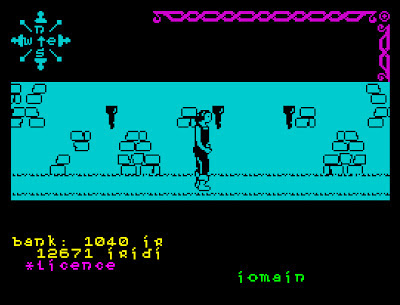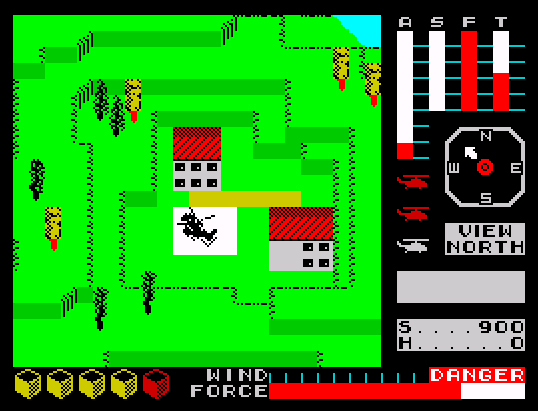Dun Darach is an adventure game that was
released in 1985 for the Sinclair Spectrum and Amstrad CPC. It is a follow up to a critically acclaimed 1984
game call Tir Na Nog. This game uses
the same engine, gameplay and character graphics as the earlier title. I didn’t include Tir Na Nog on my list as I just seemed to wander around aimlessly
with no obvious quest path. The game was
also quite confusing to navigate as it is viewed side on and can be viewed from
either side of the character. You have to walk along each path twice viewing
from each side to avoid missing anything.
Also annoying were these creatures roaming around which, if touched,
would make your character lose his items and transport him somewhere else on
the map. This was unavoidable if one of them followed you up a dead end.
I approached Dun
Darach with some trepidation as both games were highly praised when they
were released and I wasn’t looking forward to more traipsing around getting
nowhere. I needn’t have worried as Dun Darach improves on these areas. Firstly, it is set in a city rather than the
countryside and each street has a name making it much easier to navigate.
Secondly, there are more obvious things to do – within the first few minutes I found
a (locked) secret door, came across someone who wanted to exchange a map for
fur, and then had all my money stolen by a pickpocket. Dun
Darach was already looking more promising…
In this game you play a character called Cuchullain. The aim of your quest is to find your friend
Loeg who was captured by a sorceress called Skar in revenge for killing her
ally Prince Amhair of the Connachta
tribe in battle. Your search leads you
to the city of Dun Darach
I restarted after downloading a map which saved several
hours as travelling around the city is quite slow (even using the portals
located in each district). As you need money to make any progress I immediately
deposited my iridi in a bank where it would earn interest while I explored the
city. Scattered around the city are
shops, galleries, deposit houses, portals, temples, gambling houses, banks and
a thieves guild. The shops sell all
manner of objects some of which I had to google to find out what they
were. Who off the top of their head
knows what rue is? Or philtres? Or lasts from a cobbler and piles from a
herald? A lot of these objects need to be bought and placed in the four galleries
in accordance to the cryptic clues in the pictures – for example one gallery
contains a picture showing +z meaning you would drop an adze on the table. Once all the puzzles
in a gallery have been completed another object appears to help you continue
your quest. Apart from navigation the only commands are pick/drop and offer so
the tasks are limited to ‘find out what item goes where’ type quests.
 |
| This gallery was easy: lead, last, sting, hemlock.... |
 |
| ....this one not so. I think the the one on the right will be a broadaxe but the others will be trial and error. |
Of the other buildings you can store items in deposit
houses (for a fee) as you can only carry three objects at once. I did notice each deposit house has a letter
associated with it which may (or may not) provide a clue. Each
of the temples has a place to drop objects but I haven’t figured out what yet.
The gambling houses provide the quickest way to make (or lose) money. I used one of these to obtain the 10,000
iridi needed to buy licence from the thieves guild so you will no longer be
troubled by pickpockets.
I am not a great fan of adventure games (mainly because I’m
crap at them) so the fact Dun Darach
is on my list in the first place must mean something. It is
a game I think I’ll persevere with, but can see it taking many hours to finish.
Example gameplay [Amstrad CPC]
 |
| You need eagle eyes to spot secret doors - only a break in the brickwork gives them away.. |
Example gameplay [Amstrad CPC]










